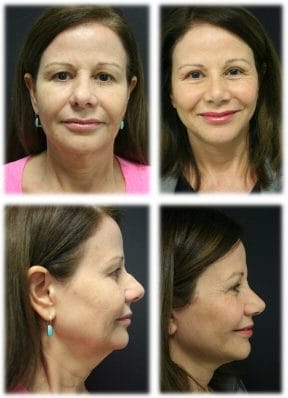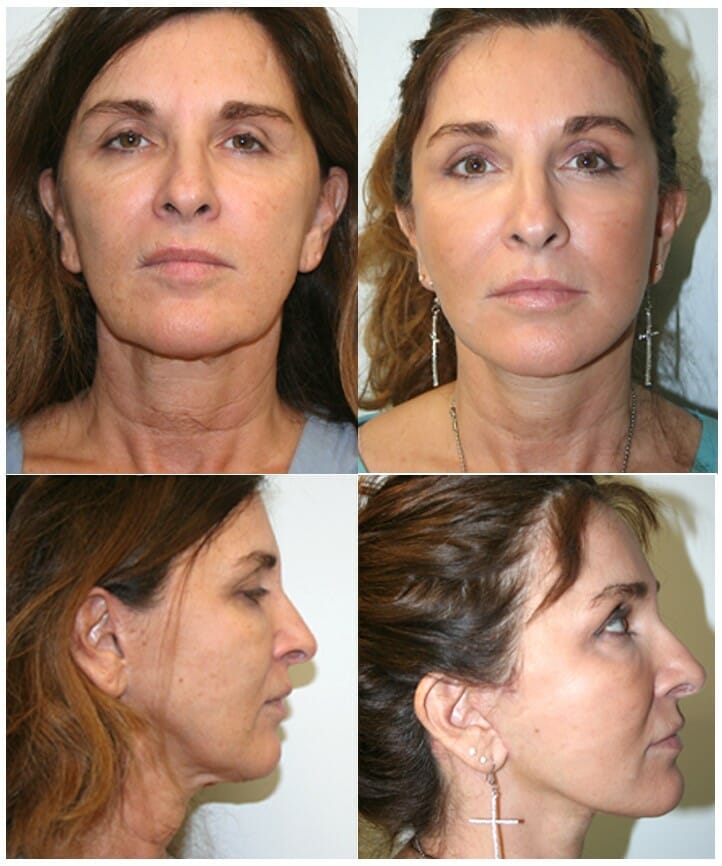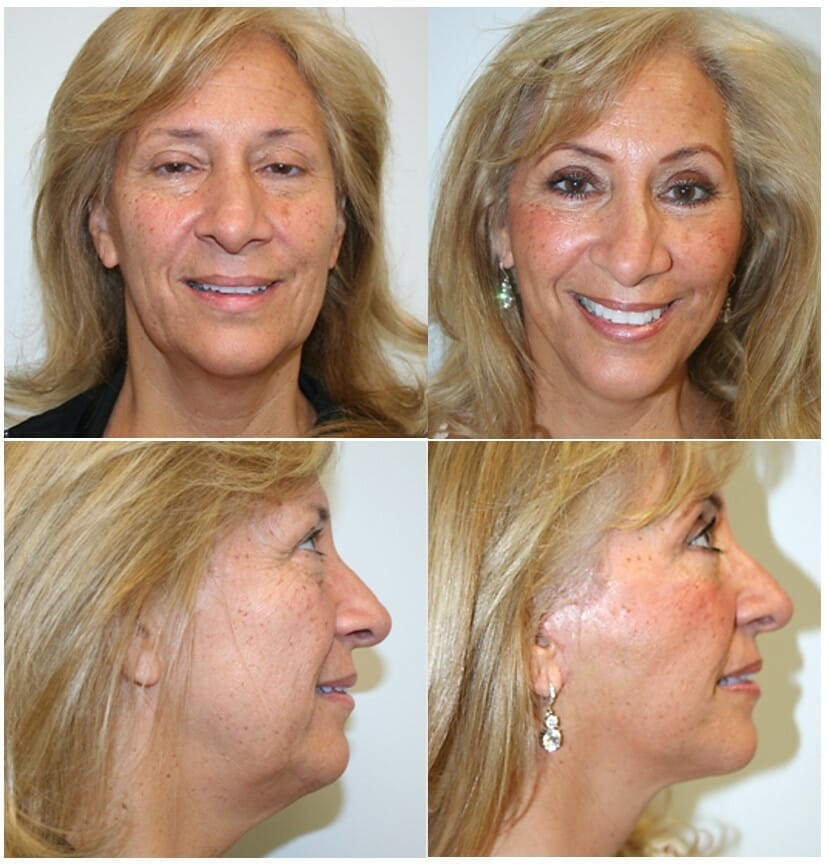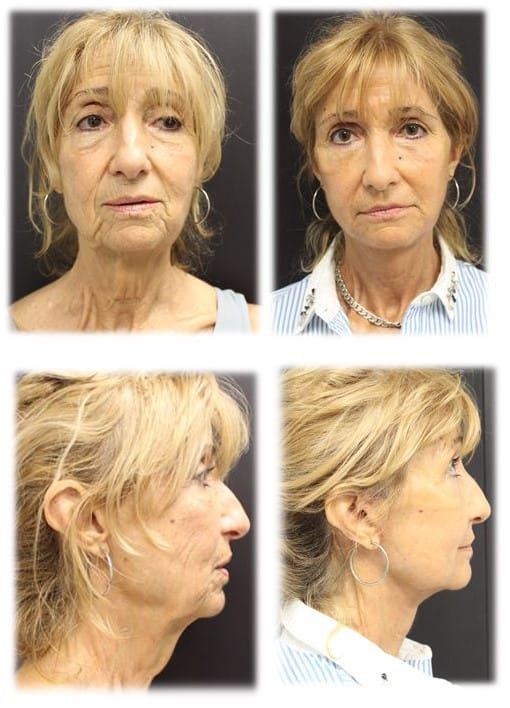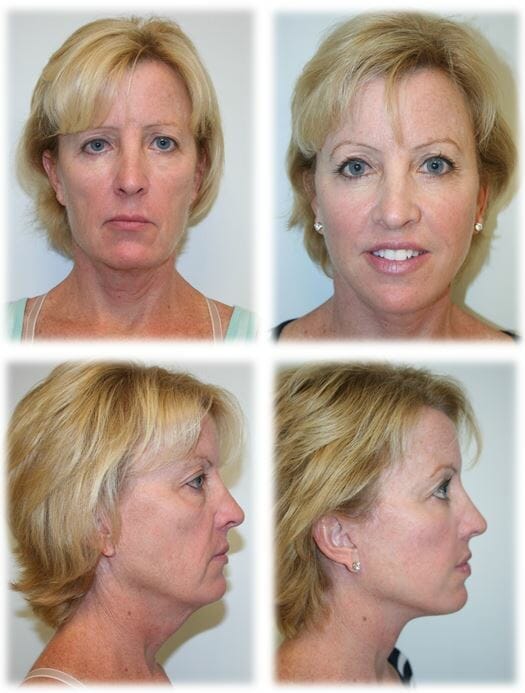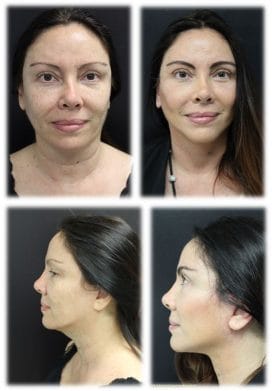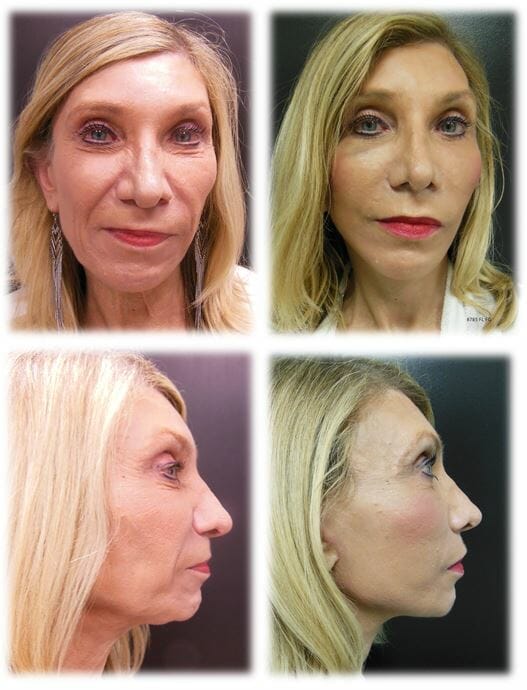Facelift in Fort Lauderdale
with Dr. ThomassenWhat can a Facelift do?
A Facelift or Rhytidectomy is a surgical procedure to rejuvenate the face and eliminate signs of aging in the face and neck. These signs include cheek descent or ptosis. They also include deep nasolabial folds, jowls and marionette lines. Additionally, neck rhytids or wrinkles and bands are observed. The procedure uses carefully placed incisions hidden in the contours of the ear and hairline to both remove excess skin and fat and reposition muscles and other tissues. Dr. Thomassen has specialized in face and neck lifts and has over 18 years of experience. He performs a variety of facelifts in our Fort Lauderdale Office/Surgical Center.
Despite multiple noninvasive options that purport to tighten facial skin, none of these modalities can compare with the results achievable with a well performed facelift. This is the only procedure than can restore a youthful look that corresponds to how people feel today.
What causes our faces to age?
A myriad of congenital and environmental factors affect how our faces age with time. As we age, loss of volume occurs due to changes in our bony structure. It is also affected by the size and position of fat pads in our face. Loss of skin elasticity and its ability to repair itself also occurs with time. Rapid weight loss, as well as exposure to toxins and even excess sunlight, can accelerate these changes. Some of these changes occur even in younger patients due to exposure to these damaging environmental factors.
The Benefits of a Facelift with Dr. Thomassen in Fort Lauderdale
With almost 20 years of experience, Dr. Thomassen offers the most current procedures tailored to your goals. Additionally, we tailor the anesthetic approach to guarantee you feel most comfortable with the procedure. You have various options for anesthesia. These range from local anesthesia only to intravenous sedation. Dr. Thomassen will discuss these options with you to ensure the right anesthetic is selected for your particular case. Moreover, we carry out this surgery in the privacy of our Office Surgical Center with a board certified Anesthesiologist or Nurse Anesthetist.
Our philosophy is that a natural look is very important and most patients desire a result that is not exaggerated or requires months to recover from. Dr. Thomassen also places significant emphasis on the placement of incisions so that scars or almost invisible when finally healed. We also value a quick recovery and long-lasting results. Dr. Thomassen will find the combination of treatments that will achieve these goals.
What are the different types of facelifts?
Mini Facelift
A mini facelift is designed to correct midface ptosis or droop, jowls and the neck wrinkles. This is done with only a lateral approach into the face and neck to correct neck wrinkles and bands. This avoids having a scar under the chin. The skin is elevated as a flap. Under the skin is the SMAS (Superficial Musculoaponeurotic System). It is lifted either together with the skin or as a separate flap. It can also be plicated with sutures if it is very thin. The skin is then redraped and excess skin removed.
Despite the term suggesting a limited result, a mini facelift is a very thorough procedure and involves a deep plane lift that aggressively lifts the cheeks, jowls and neck tissues.
The beauty of a a mini facelift is that it can be comfortably done under local anesthesia with oral sedation for comfort. It is performed in under 3 hours and by 1 week you should be healed.
Dr. Thomassen recommends this procedure for younger patients looking for facial rejuvenation. These patients should not have excessive neck rhytids or fullness. It is also a good choice for the older patient that wants a quicker procedure and recovery. It is suitable for patients who have had prior facial rejuvenation procedures and need to improve on these results.
Learn more about mini facelift procedures in our mini facelift webpage.
Face and Neck Lift
A face and neck lift, or a full facelift, uses the same incisions as a mini lift and adds a small incision under the neck to allow access to the midline of the neck. This allows for a more thorough treatment of neck bands and excess fat and other tissues. In the face, the SMAS layer of tissue (Superficial Musculoaponeurotic System) is elevated with the skin as in the deep plane technique. The platysma in the neck, paired strap muscles located under the skin are elevated and sutured together in the midline as well as lifted in their lateral aspect. This provides a consolidated neck lift. This can be performed under local anesthesia with oral sedation or with IV sedation.
What is a Deep Plane Face Lift?
In a deep plane facelift lift the skin together with the SMAS tissue is lifted in one composite flap. Dr. Thomassen believes a deep plane lift can give a more aggressive lift of the cheeks and tissues around the mouth like the jowls. This is because the skin and underlying SMAS are lifted together close to the areas requiring treatment. This achieves a strong, long lasting result. After years of experience, Dr. Thomassen has adopted the deep plane technique as his preferred method. It is a reliable and safe option even in mini lift candidates. For more information, visit our page about deep plane lifting and its benefits.
Can I have a neck lift without a facelift?
An isolated neck lift can be done using only incisions under the chin and behind the ear. It allows for removal of excess fat and other tissues in the neck and tightening of the platysma muscle les to correct excess neck fullness.
In some cases Dr. Thomassen advises doing the neck lift with a facelift at the same time since this will result in a more congruent result.
However many patients, mostly men, can benefit from an isolated neck lift to treat bothersome excess neck skin without affecting facial areas that may not be of much concern.
Who is a Good Candidate for a facelift?
Good candidates for a facelift include men and women of any age that are concerned about early signs of aging, These signs include deep nasolabial folds, jowls, and neck bands. Most commonly this is seen in patients from late 40s to later in life. Still, even younger patients show premature signs of aging due to effects of weight loss, smoking, sun exposure, etc.
Men and women with prior facial rejuvenation procedures can benefit from a secondary facelift if signs of aging have relapsed with time. There is usually no restrictions in performing a secondary or tertiary facelift as long as adequate care is taken to protect critical structures during the procedure.
Preparing for your facelift Fort Lauderdale
Medications
Any medications that result in excess bleeding will need to be stopped 2 weeks before surgery. These include anticoagulants like aspirin or non-steroidal anti-inflammatory drugs like Ibuprofen. Tylenol is safe to take before and after surgery.
Dr. Thomassen will review a list of all your medications, including homeopathic medications. Any that may have an adverse effect on wound healing, bleeding, or interact with anesthetics will need to be discontinued.
Smoking
Physical Exam
Preoperative Clearance
Dr. Thomassen will recommend the appropriate preoperative workup required according to your medical history.
In some cases, for healthy younger individuals with no medical history, a procedure can be performed without preoperative clearance.
In most individuals, a preoperative medical evaluation will be requested. Either your primary care doctor or a physician in Fort Lauderdale that we recommend will evaluate you as part of this workup. This ensures you are in an optimal state for surgery. This includes laboratory evaluation. If there are any abnormal findings from your workup, Dr. Thomassen will call you and discuss how to proceed. .
Days before Surgery
-
- Avoid strenuous exercise in the days leading up to your surgery. You should be well rested leading up to your surgery date. Also avoid excessive sun exposure.
-
- Refrain from alcohol the week before surgery. This can result in excess bleeding and more bruising after surgery.
-
- Stop using skin irritants on your face 1 week before surgery, including light peels, acne medication, and retinoic acid.
-
- Pick up your prescriptions with plenty of time before your procedure. Set up a comfortable recovery area at home. Plan to have your meals ready at home for after surgery. Include a light clear liquid meal for the first night.
-
- Plan for someone to be with you for the first 24 hours after surgery.
-
- You will get a call from our Operating Room Nurse a few days before your procedure. They will go over the consent and any preoperative details and instructions. This ensures you are ready for surgery.
-
- You will get a call from our Anesthesia Provider the day before surgery. They will go over your medications and discuss details about your anesthesia.
-
- Use antibacterial soap when showering the day before surgery.
-
- Remove any piercings or jewelry you have before coming in for the procedure.
What to expect the day of surgery
The day of your facelift surgery you will arrive at our Fort Lauderdale office at the appointed time. Wear something loose and comfortable that you can easily remove and put back on after the procedure. A button down shirt and loose pajama bottoms are ideal.
You will meet the surgical team, including a preop nurse and anesthesia provider. Dr. Thomassen will answer any final questions you have about the procedure and do some markings.
What Anesthesia is Used for a Facelift Procedure?
Facelift procedures are usually performed with IV sedation and local anesthesia. The IV sedation medications will keep you sedated during the entire procedure so you will not be aware of any of the surgery and will be comfortable throughout. Local anesthesia will guarantee you are comfortable throughout the procedure. When you wake up, you should feel comfortable, without the nausea that accompanies general anesthesia.
Facelifts can also be performed with oral sedation and local anesthesia. This would provide a lighter level of sedation so you may be aware of the procedure during surgery. If you feel you would be too anxious to undergo the procedure with oral sedation, the IV sedation option would be better for you.
How long does a Facelift take?
What is the Recovery like for a facelift
Your first follow up with Dr. Thomassen will be the next day after surgery. Dr. Thomassen will remove your dressings and the drains. A comfortable facial garment will be placed. You will be allowed to shower the next day and wash your hair. You will get further instructions on how to care of your incisions and speed up your recovery.
You should not plan to undertake any strenuous exercise for at least 4 weeks after surgery. Light walking is fine the first week and you can gradually increase exercise as you feel better.
At the 1 week visit, your sutures will start to be removed. At that point your swelling will be mostly resolved. You can start to wear makeup after this visit.
At 2 weeks, you will have any remaining sutures removed. You will be capable of being around people without any clear signs of having had surgery. You will be able to perform most normal daily living and work activities.
Thanks for visiting our site dedicated to excellence in Facelifts in Fort Lauderdale with Dr. Thomassen. Learn more about facelift recovery in our post dedicated to this topic.





